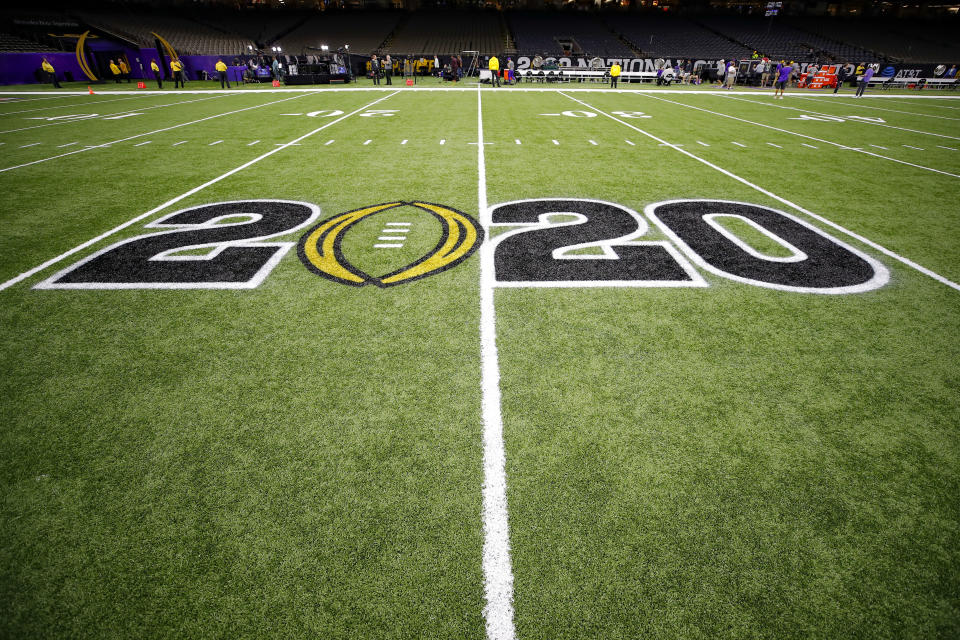College football's leadership void on full display as conferences go their separate ways
Jay Paterno, who spent two decades as a college football coach and is currently a member of the Board of Trustees at Penn State, said he was recently walking across campus when he was stopped by a professor who posed a question to him.
Would the professor be allowed to take 70 students in a plane to another Big Ten campus, where they would pack together with 70 students from the school for a combined, three-hour lecture/discussion, before returning back to State College and into the mix of the student body? And then, could he do it over and over for 10 weeks, except half the time Penn State would host the event?
“I said, ‘Hell no,” Paterno said. “To which he asked, ‘Why would you let football do that?’”
That was one part — and just one of many, many parts — of the thinking that went into the Big Ten canceling its fall football season on Tuesday.
“Really tough call,” Paterno said. “But ultimately our concern has to be with the 49,000 students on campus, not just one team.”
Is that a good reason? Is that responsible stewardship, worrying about the health of the entire campus community? Or is that erring too far on the side of caution?
John Thrasher, president of Florida State University, said Tuesday that he and other leaders in the ACC have listened to medical experts and considered the established protocols and precautions for their football programs, who as of now, are still preparing for a fall season.
“We know that we can do it safely,” Thrasher said. “... Our players want to play … Our coaches want to coach. We think it’s in the best interest of our student-athletes for us to play football. We can do it productively for them, as well as the absolute culture of our university and certainly this community of Tallahassee.”
Is that a good reason? Is that responsible stewardship, weighing the systems in place without denying the dangers of the virus? Or is that erring too far on the side of emotion and wishfulness?

College football is one sport, but it feels increasingly like it resides in two different worlds that can hardly recognize each other.
The Big Ten and Pac-12 “postponed” their fall football seasons on Tuesday — technically they could play in the spring semester, but don’t count on it. Previously, the Mountain West, Mid-American Conference and a few independent programs pulled the plug. That’s 53 schools on the shelf.
Meanwhile the ACC, Big 12 and SEC are all still on track to play, at least until medical boards tell them otherwise. So, too, are the AAC, Conference USA and the Sun Belt. That’s 77 schools still going.
Both sides, for the most part, think they are doing it right, doing the only responsible thing, listening to the proper people in the proper ways. There are divisions within the conferences — Nebraska is none too pleased about its Big Ten brethren, for example. Neither are a number of individual coaches.
Yet for the most part, the division is league by league and region by region — the West and Midwest thinking one way, everyone else the other.
It’s a conflict of cultures, perspectives and, indeed, politics.
College football, this most uniquely American sport, is as divided as the country itself.
There are intelligent, well-meaning people on both sides. There are talented medical boards and conscious decision makers everywhere. While fans are shouting and coaches are pointing fingers and the entire thing has turned into a circus, there is plenty of common ground, namely an interest in doing the right thing.
Yet there is no central authority here — the NCAA and its (well-paid) figurehead president, Mark Emmert, have no real power. The sport is divided up into 10 conference fiefdoms and a few powerhouse independents (namely Notre Dame).
They work together, at times, but mostly they compete against each other. There are no agreed-upon medical experts, no shared timetable for decisions, no shared priorities. One group might consider the wishes of the players most. Another might worry about adding to the possibility of a spread among regular students.
Who’s right? Or even better, is anyone wrong?
In the NFL, there is the NFL. You don’t have the NFC North and the AFC South at odds. You just work it out. Often quickly.
In college football, nothing really works. The sport succeeds in part because it’s a chaotic and charismatic cocktail. It’s part of the charm, at least until a pandemic hits.
In the end, maybe all the leagues decide to skip playing in the fall. Many administrators across all of these leagues and regions believe that the Big Ten and Pac-12 are just the dominoes that will knock everything over.
Or perhaps, the ACC, Big 12, SEC and others decide to go it alone, trusting their own concerns and their own experts. Nothing wrong with that, but it’s an odd existence for a sport. Rivalries are one thing; this is next level.
At least for now.
“I look forward to learning more about the factors that led the Big Ten and Pac-12 leadership to take these actions today,” SEC commissioner Greg Sankey said Tuesday. “I remain comfortable with the thorough and deliberate approach that the SEC and our 14 members are taking.”
Maybe communication will bridge gaps and improve understanding and help with these difficult decisions. Maybe college football will look like one sport, one day soon.
On Tuesday though, that felt a long way off.
More from Yahoo Sports:
